When and what fertilizer to apply to garlic in the fall: feeding schemes and a review of the best formulations to increase yields
Garlic is one of the most popular crops that almost everyone grows in their summer cottages. It is extremely beneficial for human health and at the same time is recognized as perhaps the most popular seasoning.
Any gardener strives to get the maximum harvest, but this is not always possible. Timely fertilization with the right elements at the right time will help. Today we’ll talk about when and how to fertilize garlic before winter.
Preparatory autumn activities for the garlic bed
Before planting garlic, it is necessary to prepare the bed several months in advance. The site planned for planting is dug up to the depth of a spade bayonet.. If the soil is clayey, add peat: 1 bucket for every meter of bed.
If the soil is loamy, add 3 kg of compost and humus, 1 tbsp. l. superphosphate and 200 g of lime. This is done so that the soil has time to settle and the applied fertilizers begin to interact with it. If the soil is peaty, add loam, and in sandy soil - clay and peat.
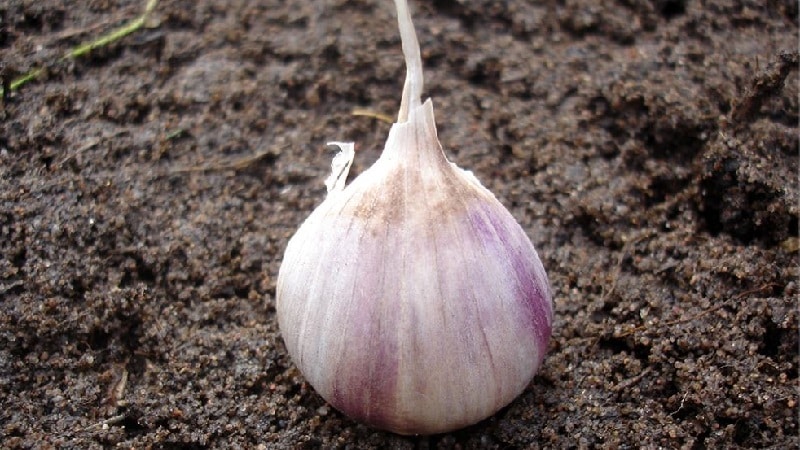
After adjusting the soil composition, the bed is treated with a solution of copper sulfate. The solution is prepared by mixing 10 liters of water and 1 tbsp. l. copper sulfate. Treat at the rate of 1 liter of solution per 1 m2 of area.
Reference. After all the preparatory work has been carried out, the area is covered with film.
The site for the garden bed should be chosen where there is a lot of sun.. The place should not be constantly wet so that the roots of the garlic do not rot. The site in the lowland is not suitable due to accumulating melt water. It is also not recommended to use a site on a hill, since in winter the snow from such a place will be blown away by the wind, and the garlic may freeze.
Basic fertilizers for garlic
Fertilizers play a major role when planting garlic.. The crop urgently needs nutrients for growth.
The following types of feeding are distinguished::
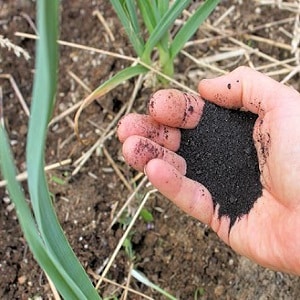 Dolomite flour or lime. It is applied to the soil to reduce acidity. The dosage depends on the degree of acidity of the soil. In some cases, wood ash can be used.
Dolomite flour or lime. It is applied to the soil to reduce acidity. The dosage depends on the degree of acidity of the soil. In some cases, wood ash can be used.- Organic fertilizers. The best option is compost with manure and bird droppings. Compost is beneficial for its content of digestible nitrogen, potassium, sulfur, phosphorus and microelements.
- Mineral fertilizers. The leader in this group is superphosphate. Wood ash can be used as the most affordable mineral fertilizer.
- Sulfur. This element is vital for the development and growth of garlic.
It can be useful:
How to plant garlic before winter
Selection of predecessors
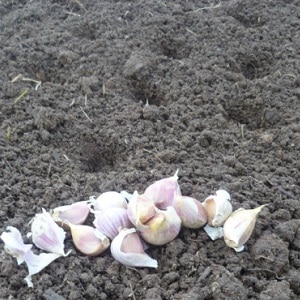 By following the rules of crop rotation, you can achieve increased productivity. The plant has a shallow root system, so it takes the substances necessary for development from the top layer of soil. It is productive to use soil after plants with a long root system.
By following the rules of crop rotation, you can achieve increased productivity. The plant has a shallow root system, so it takes the substances necessary for development from the top layer of soil. It is productive to use soil after plants with a long root system.
The best predecessors are squash and zucchini, while green manures are clover and alfalfa. A good predecessor would be a berry bush. A good option is the soil after tomatoes, cucumbers, peppers, cabbage and pumpkins.
You can't plant garlic after onions., since these plants are attacked by the same pests.
It is not recommended to plant garlic near a bed of beans, peas or cabbage.. These crops do not tolerate the proximity of garlic - it interferes with their growth and development.
Attention! If there is not enough space in your summer cottage, you can find a way out by adding garlic to strawberries, cucumbers, currants, and raspberries.
Determination of soil acidity
The best choice for garlic would be neutral or slightly acidic soil.. When analyzing soil acidity, the pH should be above the neutral value of 6.5. An indicator of acidity is the weeds growing on the soil chosen for planting.
The presence of plantain, mint, and buttercup indicates that the soil acidity is increased. If the soil is neutral or slightly acidic, nettles, cornflowers, clover, and chamomile grow on it.
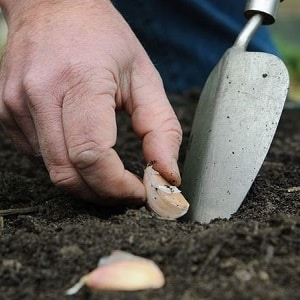 There are ways to determine soil acidity:
There are ways to determine soil acidity:
- Soil meter. Using a special device, you can accurately determine the condition of the soil.
- Vinegar. If you pour vinegar on a handful of soil, bubbles should appear on its surface. If this does not happen, then the acidity is increased.
- Currant, cherry or bird cherry leaves. The leaves of any of these plants are poured with boiling water, wait for the water to cool, and add soil to it. If the color of the water changes to red, it means that the acidity is increased. If it turns green, the soil is neutral. If the water turns blue, this indicates that the soil is slightly acidic.
When the soil is highly acidic, plants are unable to absorb nutrients. Garlic roots practically do not develop in acidic soils.
Fertilizers that are suitable for winter garlic
Thanks to the use of the correct fertilizer garlic will be able to accumulate more nutrients, the plant’s immunity will be strengthened, and its resistance to pests and diseases will improve.
Mineral and organic fertilizers are used for winter garlic. There are a number of ways to improve soil fertility when growing garlic.
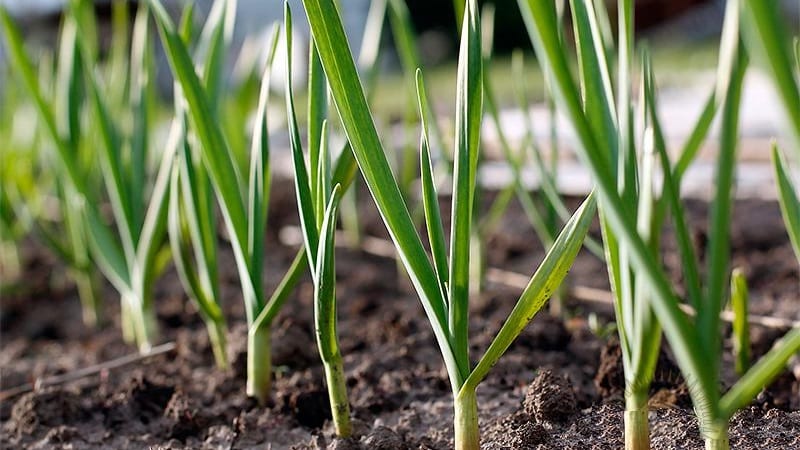
Improving the soil with green manure
The use of green manure will have a beneficial effect on the quality of the crop. Garlic grows well after such predecessors.
On a plot of land adapted for planting garlic, green manure plants need to be planted at the end of July. Green manures include barley, rye, and mustard. Their roots and green mass contain phytoncides and essential oils that destroy viruses and fungi that attack garlic.
A few weeks before planting, green manure is mowed and dug up.. In this case, young shoots of green manure plants are left underground to rot. To speed up the process of rotting, the dug up bed is moistened. During the decomposition process, the soil will be saturated with useful microelements that are important for the development of garlic.
Improving the soil in this way is comparable in effectiveness to using humus or compost. The soil becomes lighter, looser and saturated with oxygen.
Feeding with chemicals
Chemical mineral fertilizers have a beneficial effect on the development of garlic heads. What fertilizer should be applied to garlic in the fall? Before planting, superphosphate and potassium salts are used. With the help of potassium, it will be easier for the plant to survive the winter, as it has a beneficial effect on the formation of the root system.
Read also:
Mineral fertilizers for garlic
Mineral fertilizers have a beneficial effect on the development of garlic. Before planting garlic in the fall, you need to add:
- Nitrogen-containing fertilizers: ammonium nitrate, urea, calcium and sodium nitrate. Nitrogen maintains a balance in the growth regulation process between the head of garlic and the herbs.
- Fertilizers containing phosphorus and potassium. The most common of them is superphosphate.
Mineral fertilizers are added to the soil in dry form in the fall. They are not specially diluted with water so that beneficial microelements enter the soil gradually.
Organic (ash and manure)
Manure is one of the best fertilizers, but there is no need to add this fertilizer in the fall. When using manure in the fall, the garlic heads will become loose, and the plant will not be able to resist fungal diseases. Another disadvantage is that after adding manure to the soil, the garlic will begin to grow rapidly, and the growth of the head will slow down.
One of the mandatory fertilizers used when planting garlic is ash.. It contains many microelements. Ash is added to the soil during the digging process or used during planting.
It won't be amiss application of the ash solution after a few weeks. A solution is prepared by mixing 1 liter of water and 1 tbsp. l. ash. For 1 sq. m of planted garlic, 3 liters of solution is enough. The use of ash helps to increase the size of garlic heads.
Features of foliar feeding
This method of feeding is used when the plant has a need for specific microelements.. It consists of applying fertilizer by spraying the outer part of the plant, which promotes faster absorption of beneficial microelements.
Important! When spraying, a lower concentration of solution is used than with the traditional method of fertilizing.
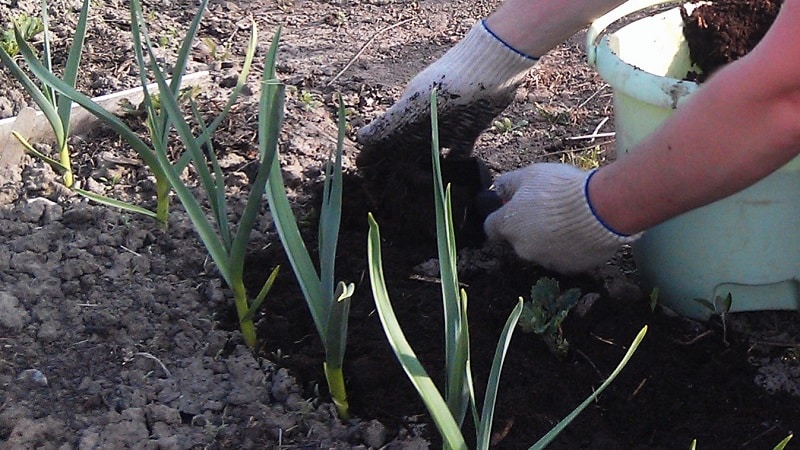
It is important to follow the rules for foliar feeding:
- Spraying is carried out with a fine spray.
- Do not oversaturate the solution used for feeding. Otherwise, you may burn the garlic greens.
- Frequent feeding is harmful. Foliar feeding is carried out three times.
- It is better to choose the time in the morning, if the weather is cloudy, or in the evening. It is important to note that the leaves must dry before nightfall.
When and how often to feed garlic: schemes
If planted in autumn, garlic does not require increased nutrition.. But you definitely need to add humus to the soil to increase its fertility. They begin feeding garlic after the snow cover has melted.
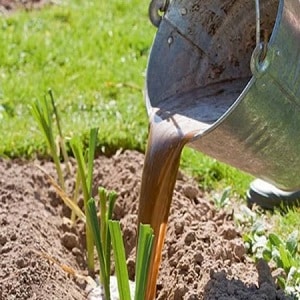 Throughout the season, fertilizing is carried out three times.:
Throughout the season, fertilizing is carried out three times.:
- A few weeks after the snow melts. At this time, garlic needs nourishment. The ovaries are beginning to form, and the plants will have to contend with possible last frosts. Fertilize with a solution of urea or boric acid. It doesn't hurt to add a solution of manure.
- 3 weeks after the first fertilizing to replenish the supply of microelements in the soil. The most commonly used solution is boric acid. In rare cases - urea again. Again, a solution of manure will not be superfluous.
- In mid-summer, during the formation of the garlic head to increase its size. For these purposes, a superphosphate solution is used.
Conclusion
It may seem that garlic is unpretentious and does not require special attention. But to get a good harvest, you need to approach the growing process seriously and remember how to fertilize this crop when planting before winter.
To obtain a rich harvest, garlic is fed in the fall by adding green manure, chemicals, mineral and organic fertilizers - urea, superphosphate, ash and manure - to the soil.
For several years, when planting garlic in the fall, I have been using “Gumi-Omi Onion, Garlic.” When planting between rows, I add Nurse Mycorrhiza. Mycorrhizal fungi form a symbiosis with roots. Thanks to this, the absorption capacity of the root system and the plants receive water and nutrients much more easily. In addition, beneficial mushrooms, by their presence, prevent the development of pathogenic microbes. The plot is very small - crop rotation is not possible. In the summer I carry out prophylaxis with the drug “Fitosporin”. Every year I get a good harvest.